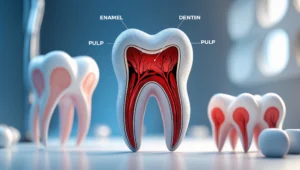The aftermath of a dental appointment with a dental filling near you can sometimes feel like a victory lap. You’ve conquered a cavity, addressed a potential dental issue, and (hopefully) walked away with a brighter, healthier smile. But for some, that celebratory feeling can be interrupted by a sudden, unwelcome guest: tooth sensitivity. That sharp twinge with a sip of coffee or a dull ache when brushing can be a real nuisance.
While post-filling sensitivity might catch you off guard, it’s pretty standard. Let’s delve deeper into the reasons behind this sensitivity and explore ways to keep the discomfort at bay.
Unpacking the Fortress: Understanding Tooth Anatomy
Imagine your tooth as a complex fortress. The tough outer layer, the enamel, acts as the shield, protecting the softer interior. Beneath this shield lies the dentin, a porous layer riddled with microscopic tubes. These tubes lead directly to the heart of the tooth – the pulp, where the nerve resides.
During a filling procedure, dentists need to remove decayed material. Depending on the severity of the decay, this process might expose some of those tiny dentin tubules. Think of them as open pathways leading straight to the nerve center. When you introduce hot, cold, sweet, or acidic stimuli, those sensations travel down the exposed tubules, directly triggering the nerve and causing that familiar zap of pain.
Another potential culprit for post-filling sensitivity is nerve irritation. Deep dental fillings, where the decay reaches closer to the pulp, can sometimes irritate the nerve itself. It can lead to a sharper, lingering pain that feels different from the typical sensitivity to temperature or sweets.
The Filling Factor: Material Matters (Sometimes)
The type of filling material used might also affect sensitivity. Traditional amalgam fillings, the familiar silver ones, have been around for decades and generally cause less sensitivity compared to their newer counterparts, composite resin fillings. These tooth-colored fillings offer aesthetic advantages but might cause more sensitivity, especially after placement.
However, it’s important to remember that individual sensitivity varies. Some people are more prone to experiencing discomfort after any dental procedure, regardless of the filling material. This heightened sensitivity can be due to naturally thinner enamel or a lower pain threshold.
Taming the Twangs: A Multi-Pronged Approach to Managing Sensitivity
The good news is there are ways to manage that post-filling sensitivity and minimize the discomfort. Here’s a toolkit of strategies you can consider:
- The Sensitive Toothpaste Ally: These specialized toothpaste contain ingredients like potassium nitrate. This magic ingredient acts as a shield for your exposed nerves by helping to block the dentin tubules. When these tubules are sealed, hot, cold, and sweet sensations have a more challenging time reaching the nerve, reducing that familiar twinge.
- Desensitizing Products: Gels and Mouthwashes to the Rescue: Consider incorporating desensitizing gels or mouthwashes into your routine for an extra layer of defense. These products often contain similar ingredients to sensitive toothpaste but might deliver a more concentrated dose, providing targeted relief for sensitive teeth.
- Dietary Champions: Choosing Kindness for Your Teeth: While steaming coffee or refreshing ice cream might be tempting, consider giving your teeth a break from extreme temperatures. Sugary treats and acidic foods can also trigger sensitivity. Opt for lukewarm beverages and milder meals for a few days after filling. It allows the exposed dentin tubules time to heal and reduces the intensity of the sensations reaching the nerve.
- Over-the-Counter Relief: A Temporary Fix: For short-term pain relief, over-the-counter pain killers like ibuprofen or aspirin can help. Remember, these medications address the symptom, not the cause, so consult your dentist if the pain persists over a few days.
Communication is Key: Building a Dialogue with Your Dentist
If you experience sensitivity after a dental filling, don’t hesitate to contact your dentist. They are your partners in oral health, and open communication is crucial for a smooth recovery process.
Early detection and addressing any concerns can help ensure a smooth recovery process. By voicing your concerns early on, dentists in Parkland can assess the cause of the sensitivity and recommend the most appropriate treatment. The filling may need a minor adjustment, or maybe a desensitizing medication is better.
Beyond the Basics: Additional Tips for Managing Sensitivity at Home
To deal with sensitivity even better at home, here are some more things you can do:
- The Cool Compress Cure: Apply a cold compress to your cheek near the affected tooth. The cold temperature can help numb the area and temporarily relieve discomfort.
- Gentle Flossing is Essential: Good oral hygiene is crucial for dental health, even with a sensitive tooth. However, be extra gentle when brushing and flossing around the filled tooth for a few days. This will help minimize further irritation and allow the area to heal correctly.
- Alternative Approaches: Exploring Additional Options: Some people find relief with alternative therapies like acupressure or clove oil. People think that acupressure can help relieve pain by giving light pressure to certain spots on the body. Clove oil, a natural pain reliever, can be applied topically to the gum tissue near the affected tooth (diluted with a carrier oil). However, you must consult a dentist before trying such remedies. For your unique case, they can tell you if these other options are safe and if they will work.
The Final Note: Maintaining Vigilance and Seeking Help When Needed
Tooth sensitivity after fillings is a shared experience, but it doesn’t have to disrupt your routine. By understanding the causes and employing these coping strategies, you can keep the discomfort at bay and get back to enjoying your favorite foods and beverages. Remember, a little vigilance goes a long way.
Here are some additional points to keep in mind:
- Be Patient: Sensitivity after fillings usually subsides within a few days to a week. Be patient and allow your teeth time to adjust to the new filling.
- Monitor the Discomfort: While some sensitivity is expected, if the pain is severe, persistent, or accompanied by swelling, contact your dentist immediately. These could be signs of a more severe issue requiring further evaluation.
- Regular Dental Checkups are Key: Maintaining regular dental checkups and cleanings is crucial for preventing cavities and ensuring oral health. These appointments also allow a dental office near you to monitor any potential issues and address them promptly. By scheduling regular checkups, you can minimize the need for fillings in the future, reducing the chances of experiencing post-filling sensitivity.
Conclusion: A Smile Worth Fighting For
A healthy, beautiful smile is vital for overall well-being. Post-filling sensitivity is temporary, but it shouldn’t hinder your dental care. Understand the causes and employ management strategies to maintain a confident smile. Remember, Daily Smiles – Parkland is here for you. If you have questions or need support, don’t hesitate to contact our expert dentist, Dr. Michelle Gonzales.
Schedule an appointment with our practice now and start your path to beautiful, healthy teeth and a self-assured smile.






